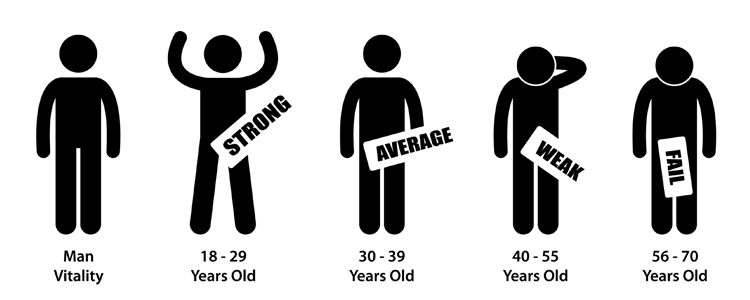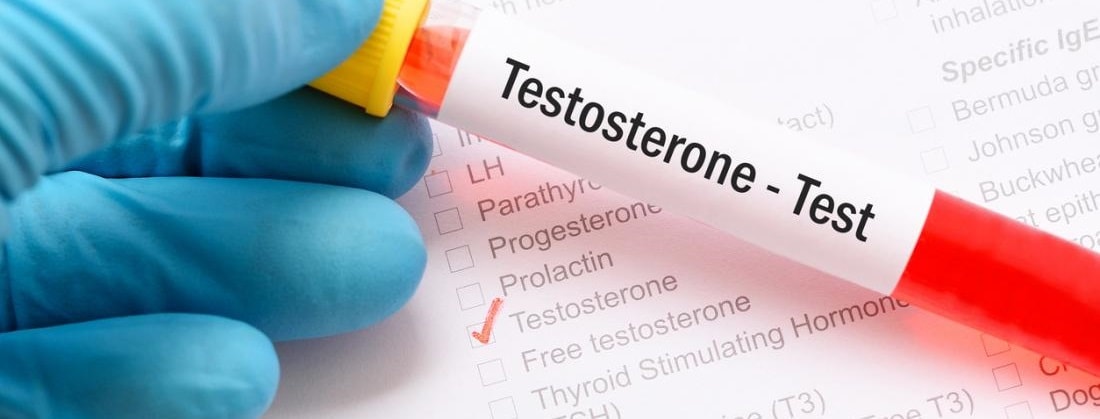Therapy of Age-Related Androgen Deficit
Also known as low testosterone (or low T) and male hypoandrogenism, androgen deficiency (AD) happens when androgen levels fall below standard age-related concentrations. Testosterone is the most important androgen. In the paragraphs below, the experts of Canadian Health&Care Mall have summarized key insights on androgen deficiency in general and age-related low testosterone in particular.
Androgen Deficiency and Ageing
Unlike typical menopause in women – when estrogen levels plunge and stop almost entirely – testosterone levels in men gradually drop by 1-2% percent per year after age 40 and this process may proceed over dozens of years.
Many existent studies confirm that androgen deficiency syndrome affects only a minority of the male population. A recent survey called Male Aging Study in Massachusetts estimated that only 12.2% of men 40 to 69 years of age are ‘maybe’ androgen deficient and 2.3% are ‘definitely’ androgen deficient.
 The European Male Ageing Study has provided its own estimate of the prevalence of low T:
The European Male Ageing Study has provided its own estimate of the prevalence of low T:
- in men aged 50–59 about 3%
- in men aged 60–69 about 9.6%
- in men aged 70–79 about 23.5 %
- in men aged over 80 about 34.3%
Thus, the terms “male menopause” or “andropause” are not really applicable. These terms are being replaced by the term “partial androgen deficiency of the ageing man” (PADAM, see what is it on NCBI: https://www.ncbi.nlm.nih.gov/pmc/articles/PMC3376477). Nowadays, PADAM is the focus of serious research aimed at finding a balanced basis for hormone replacement therapy in ageing men.
Low testosterone in older males can be caused by diverse concurrent mechanisms, such as age-related deteriorations of the pituitary gland, decline of the neuro-hypothalamic system, structural gonadal impairment, and metabolic abnormalities such as the age-related surge in the concentrations of SHBG (serum sex hormone binding globulin).
It is debatable whether aging is the only factor of age-related T decline. Instead, several factors seem to interfere in different ways with T metabolism, such as chronic diseases, chronic medications, genetic factors, obesity, and other lifestyle factors.
Androgen Deficiency Symptoms
Since the decline of testosterone levels in men occurs so gradually, the onset of symptoms might be ill-defined and subtle.
Symptoms may include:
- decline or loss of libido or sexual desire
- reduced volume of semen
- diminished muscle mass
- reduced orgasmic quality
- hair loss
- hot flashes
- sweating
- nervousness
- insomnia
- irritability
- fatigue
- diminished energy levels
- short-term memory problems
- lack of motivation
- falling self-esteem
- depression
- reduced muscle strength
- abdominal obesity.
Other signs related to AD include osteoporosis, increased total body fat, reduced high-density lipoprotein (HDL) cholesterol, as well as reduced share of red cells in plasma.
Contrary to popular belief, erectile dysfunction (ED) is rarely connected to androgen deficiency. If sexual desire is in place, but function is not, the problem does not originate from low testosterone levels and hence testosterone replacement should not be suggested as a therapy. In such case, ED therapies should be applied.
Many androgen deficiency symptoms might come from other disorders or they might be normal manifestations of getting older. Therefore, diagnosis of AD should never rest on symptoms alone.
How is AD Diagnosed?
The diagnostic method for AD includes a physical examination, as well as laboratory tests and a medical history review. The physical examination includes palpation of the testes to check for consistency and volume, evaluation of secondary sexual characteristics such as musculature, body hair distribution, and breast size. In men 50 and older, a digital rectal examination is often required, to check the size of prostate.

Laboratory tests are conducted to identify testosterone levels. In many cases, other hormones, such as follicle stimulating hormone (FSH) and luteinizing hormone (LH) are measured as well. The experts of Canadian Health&Care Mall recommend that blood samples for testosterone tests be taken between 8 and 10 a.m. on two individual days. A reliable diagnosis of androgen deficiency can only be made when the testosterone levels are established and evaluated against physical symptoms.
The measurements of serum total testosterone (TT) levels are the basis for laboratory diagnosis of AD. While there is no universally accepted threshold for testosterone in mature men, TT levels over 350 ng/dL are considered normal, while TT levels under 230 ng/dL, and especially under 200 ng/dL are considered low and usually benefit from testosterone supplementation. When total testosterone range is between 230 and 350 ng/dL, it may be useful to measure free testosterone (FT) levels, especially in overweight men. FT level lower than 65 pg/mL usually suggests that testosterone supplementation will be beneficial.
Androgen Deficiency Treatment
Testosterone replacement therapy (TRT, learn more) is a common method for treating patients with AD. The goal of TRT is to bring testosterone into the normal range, but not outstrip that range. TRT should not have undesirable effects on the prostate, serum lipid levels, as well as cardiovascular, lung and liver functions. Modern patients increasingly prefer to administer TRT themselves with minimum discomfort.
Nowadays, several administration methods are available: intramuscular, oral, as well as transdermal and implant preparations. The appropriate delivery method needs to be determined in consultation between the patient and the healthcare practitioner.
Intramuscular TRT
The most popular TRT preparation are testosterone esters, such as testosterone enanthate. They are dispensed by 250 mg intramuscular testosterone replacement injections at intervals of several weeks, and the doses are supraphysiological instantly after the injection. A few days in advance of the next injection, T levels frequently drop to the subnormal range. The patient often experiences the roller-coaster effect.
Testosterone bucyclate has an excellent therapeutic profile and maintains a reasonably constant level of testosterone for up to three months at a dose of 600 mg. Testosterone cipionate (commonly known under Depo-Testosterone brand) is another promising preparation for long-term TRT.
Oral TRT
Among the oral forms of delivery available to date, the 17-alpha- alkylated androgens have shown to be hepatotoxic and their popularity is therefore in decline. Testosterone undecanoate absorbed via the lymphatic vessels can be delivered orally. Due to the short half-life, several administrations per day are needed. The fluctuations in T levels represent a disadvantage.
Transdermal TRT
Reasonably constant plasma levels can be sustained with the transdermal administration method. Transdermal patches, widely known under Testoderm brand, must be applied to the scrotal skin every day to absorb the amount of testosterone required for replacement. The disadvantages are represented by shaving of the scrotum, as well as high risk of transfer to household members.
Implant TRT
The implantation of testosterone pellets is not common but it is noteworthy, since constant testosterone levels for up to 6 months can be ensured.
Testosterone Replacement Therapy Risks
Men who have prostate cancer or male breast cancer should avoid TRT. All men considering TRT should undergo a full prostate cancer screening before starting this therapy. While testosterone does not trigger the cancer, it may boost its growth if the cancer is already present. Advanced age (80 years and above) appears to be a risk factor for prostate cancer and must be considered when discussing the TRT.
The increased prostate risk of long-term testosterone supplementation has not been fully established. Yet, the experts of Canadian Health&Care Mall recommend monitoring procedures for men receiving exogenous testosterone including checkups of liver function, PSA, body weight, rectal-digital palpation, erythropoiesis, as well as prostate volume, among others.
As it was already mentioned, the exposure to transdermal testosterone products represents major risk for household members including female partners, children, and even pets. Testosterone gels can trigger excessive hair growth on women’s arms and faces, interrupt menstruation and deepen their voices. In children, contact with T creams and gels can cause early puberty and belligerence. In pets, such products can cause enlargement of the genitalia and aggressive conduct.
Alternative Testosterone Enhancing Products
Experimental products that are believed to deliver androgens, including testosterone, are increasingly available. Dehydroepiandrosterone and sulfate (DHEA and DHEAS), and other androgenic steroid precursors are the examples of such experimental products available on sports nutrition market. Currently, the use of DHEA with testosterone replacement is not widely accepted and is being researched by the medical expert community.
Testosterone Replacement Therapy is Not a Youth Elixir
Some men want to believe that ageing is nothing else than a reversible form of androgen deficiency, according to Canadian Health&Care Mall’s experts. This is not supported by scientific evidence. Numerous well-designed clinical studies of the effects of androgens in older men have regularly indicated only modest improvements in body composition (1–3 kg reduced fat and increased muscle mass), and almost no objective benefits in psychosexual function.
The benefits of TRT for men affected by obesity and chronical conditions are not yet known. In general, testosterone therapy for ageing men has not yet become a routine therapy since it still raises questions regarding its risk-benefit profile.
While TRT can be effective in proven cases of testosterone deficiency, it is not an anti-ageing elixir for mature men, note the experts at Canadian Health&Care Mall.


